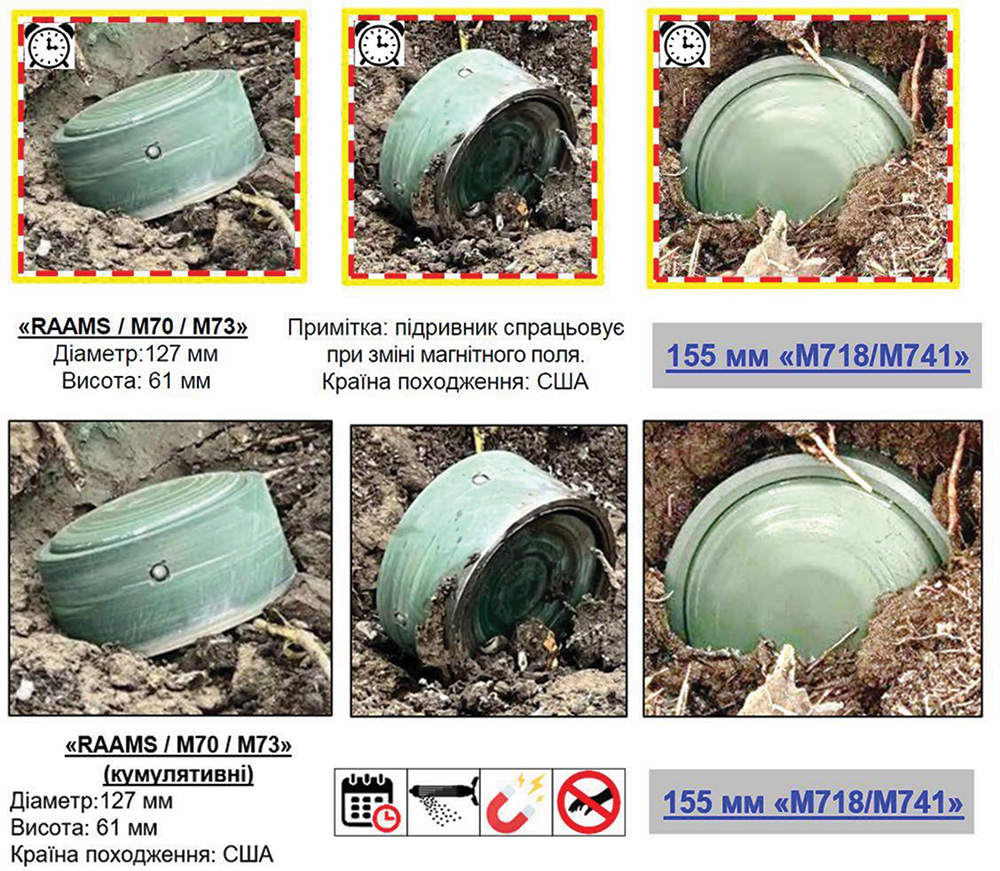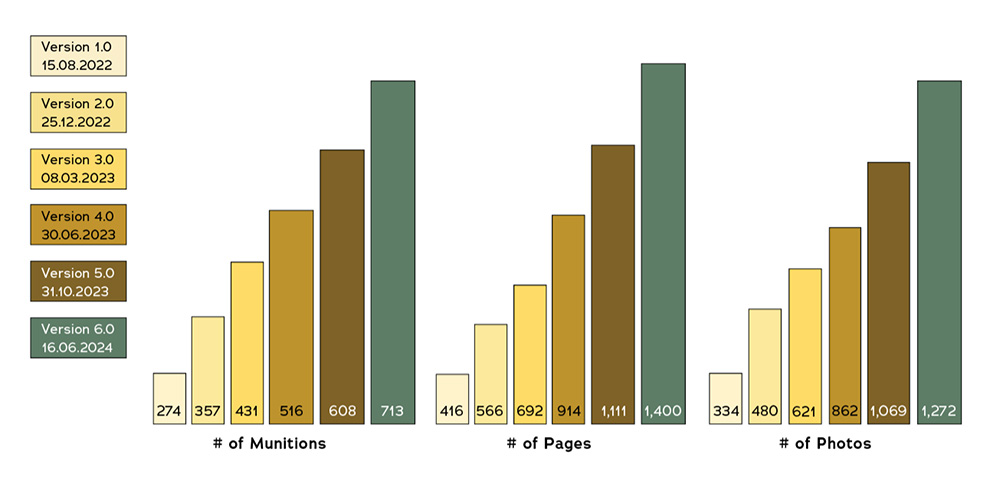Basic Identification of Ammunition in Ukraine Guide: Version 6.0
CISR JournalThis article is brought to you by the Center for International Stabilization and Recovery (CISR) from issue 28.3 of The Journal of Conventional Weapons Destruction available on the JMU Scholarly Commons and Issuu.com.
By Senior Lieutenant Perederii [ National Police of Ukraine Explosive Ordnance Disposal ],
Tony Salvo, and Drew Prater [ Bomb Techs Without Borders ]
Ordnance identification is a critical tenet of any competent munition clearance operation, whether it be civilian or military. Ordnance identification information for first responders, especially safety procedures, is vital when shielding civilians from danger. This is even more important when the munitions being cleared are explosive remnants of war (ERW) from on-going conflict. To that end, Version 6.0 of the Basic Identification of Ammunition in Ukraine1 has been released and has some important updates to help ensure clearance personnel and first responders can help keep civilians safe.
Introduction
The guide was originally developed in the summer of 2022 by Bomb Techs Without Borders2 (BTWOB) and the National Police of Ukraine Explosive Ordnance Disposal (EOD). Since that time, the eighth Special Operations Forces Regiment EOD and State Emergency Services of Ukraine EOD have joined as major contributing partners. Numerous other agencies, units, and departments contribute in an ad hoc, unofficial capacity. The types of information contained in the guide are deliberately limited to allow for maximum distribution without compromising operational security.
In Version 6.0, indicators for specific hazards have been expanded from six to fourteen and use a clearer, more intuitive system for hazard identification. Rather than using a color-coding system bordering each affected munition, which was quickly becoming very complicated, the system was switched to utilizing basic symbols. As illustrated in Figure 1, the generic clock symbol, broken red band, and solid yellow band have been replaced by four symbols which denote long-time delay, dispensed, magnetic sensitive, and do not touch. The symbols should identify specific munition hazards to the user on sight at the munition entry and not require the user to go back to the index to identify the color code.
Another addition is the intended effects or method of operation for the munition. Like the hazard symbols, this provides important information to the user about either the munition’s content or basic information about how the fuze functions, further aiding in keeping the people of Ukraine, as well as clearance teams and first responders, safe.
As illustrated in Figure 2, an additional 105 new munitions, 289 new pages, and 203 additional photos have been added to Version 6.0. This graph does not show the additional information added to existing entries or the updated photos with better images from the field as new information and pictures become available.

In a never-ending effort to ensure (as much as humanly possible) that the information presented in the guide is 100 percent accurate, a formal quality assurance/quality control process has been in place since Version 4.0. Prior to publication, EOD volunteers from the team from all over the world selected random entries in both the Ukrainian and English editions and checked the information against other references and/or field data. BTWOB linguists also conduct a thorough review to ensure the correct language and descriptions are used.
While the guide is expansive, additional information is always needed for new and old entries alike. Countless munitions have been donated/sold to Ukraine to help in the war, but that does not mean the guide has the required basic technical information to ensure safety for the people of Ukraine. Additionally, accurate information is always needed, especially if provided by the donating entity.

Version 7.0 is currently in development and is planned for publication in October 2024. The main focuses for Version 7.0 will be:
Adding new munition entries to keep up with the ever-growing influx of ammunition from both friendly and hostile sources.
Exploring a different platform or media through which to publish the guide. Due to its ever-expanding size, there is probably only one more version that can exist as a .pdf document.
Convincing other Ukrainian demining and EOD departments to contribute to the guide.
See endnotes below.
 Senior Lieutenant Perederii currently serves in the National Police of Ukraine (NPU) EOD and has been the primary NPU representative for the ammunition ID guide’s development since the first edition. Senior Lieutenant Perederii has been in law enforcement for over nine years and an EOD officer for five years. He graduated from the EOD school in Merefa, Ukraine, in 2020 and has also attended numerous training courses overseas throughout his career.
Senior Lieutenant Perederii currently serves in the National Police of Ukraine (NPU) EOD and has been the primary NPU representative for the ammunition ID guide’s development since the first edition. Senior Lieutenant Perederii has been in law enforcement for over nine years and an EOD officer for five years. He graduated from the EOD school in Merefa, Ukraine, in 2020 and has also attended numerous training courses overseas throughout his career.
 Tony Salvo is a former US Army enlisted EOD technician (eight years) with extensive combat experience in the Iraq and Afghanistan conflicts. Previously, he has worked in the humanitarian sector in Iraq and Syria clearing explosives hazards left from the ISIS conflict. Currently he serves as the Branch Director and Senior Technical Advisor for Bomb Techs Without Borders in Ukraine.
Tony Salvo is a former US Army enlisted EOD technician (eight years) with extensive combat experience in the Iraq and Afghanistan conflicts. Previously, he has worked in the humanitarian sector in Iraq and Syria clearing explosives hazards left from the ISIS conflict. Currently he serves as the Branch Director and Senior Technical Advisor for Bomb Techs Without Borders in Ukraine.
 Drew A. Prater is a former US Army EOD Technician (nineteen years) who has worked internationally for the past eighteen years conducting humanitarian and commercial clearance and training operations throughout Afghanistan, Burkina Faso, Cambodia, Iraq, Jordan, Mali, Nigeria, Pakistan, Thailand, Ukraine, and Vietnam. He has also authored and co-authored numerous articles for professional journals and publications. He is currently an EOD/IED Technical Advisor volunteer with Bomb Techs Without Borders and an independent EOD/IED contractor.
Drew A. Prater is a former US Army EOD Technician (nineteen years) who has worked internationally for the past eighteen years conducting humanitarian and commercial clearance and training operations throughout Afghanistan, Burkina Faso, Cambodia, Iraq, Jordan, Mali, Nigeria, Pakistan, Thailand, Ukraine, and Vietnam. He has also authored and co-authored numerous articles for professional journals and publications. He is currently an EOD/IED Technical Advisor volunteer with Bomb Techs Without Borders and an independent EOD/IED contractor.

